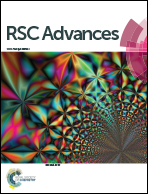Synergistic flame retardant properties of a layered double hydroxide in combination with zirconium phosphonate in polypropylene
Abstract
High-performance flame retardant nanocomposites were prepared for polypropylene (PP). The nanocomposites consisted of an organic-modified layered double hydroxide (LDH) in combination with zirconium 2-(2-(2-aminoethylamino)ethylamino)ethylphosphonate (ZrP) compounds containing phosphorus and nitrogen. The composition, thermal stability and mechanical properties of the nanocomposites combined with PP were studied by X-ray diffraction, scanning electron microscopy, thermogravimetric analysis and differential scanning calorimetry. The flame retardant behavior was observed using a microscale combustion calorimeter. As an effective synergistic flame retardant, the addition of the nanocomposites resulted in a significant decrease in the heat release rate compared with pure PP. When the load of LDH in combination with ZrP was 5 and 15% (a ratio of 1 : 3), the peak heat release rate was reduced by 28.2%. The flame retardant showed good dispersion in the PP matrix. The improved flame retardant performance may be because LDH and ZrP decomposed to produce non-combustible gases, which diluted the combustible gases, and a compact char layer that acted as a fire barrier.


 Please wait while we load your content...
Please wait while we load your content...